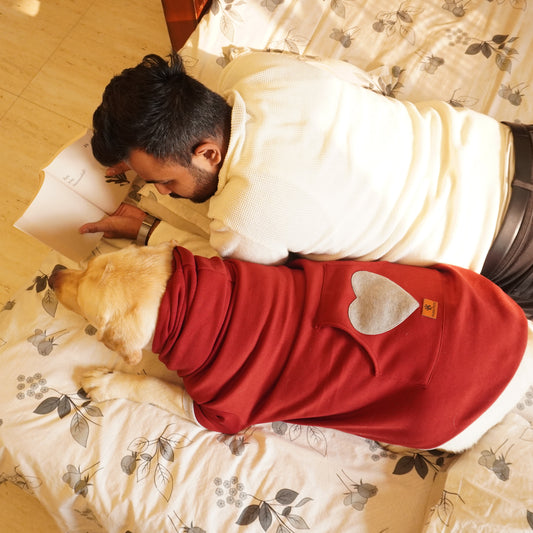As a dog parent of a Sarabi dog, there is a lot to love about this magnificent breed. The Sarabi, also known as the Persian Mastiff, is a large, powerful, and loyal breed with a heart as big as its imposing stature. Known for their gentle yet protective temperament, Sarabis are not only an excellent choice for those looking for a dedicated companion but also an effective guard dog. If you're considering adding one of these majestic dogs to your family or just want to learn more about them, this guide will provide you with everything you need to know, from their temperament and training to their price and care requirements in India.
Introduction to the Sarabi Dog

The Sarabi dog is native to Iran, where it has been bred for centuries to guard livestock. This breed has a long history of protecting flocks of sheep and other livestock from predators such as wolves and bears. Their ability to stand their ground, combined with their impressive size and strength, made them invaluable working dogs in rural Iran and parts of Central Asia.
The name "Sarabi" is derived from the Sarab region in Iran, where these dogs were initially bred. Sarabi dogs are descendants of ancient mastiffs, and their lineage is believed to trace back to some of the earliest guard dog breeds. They were specifically bred for their protective instincts, making them exceptional guardians of both livestock and property.
Physical Characteristics of the Sarabi Dog
One of the first things you'll notice about a Sarabi dog is its sheer size. As a mastiff breed, these dogs are large and powerful. Males typically weigh between 110 to 150 pounds (50 to 68 kg), while females usually weigh between 90 to 120 pounds (40 to 55 kg). In terms of height, they stand around 28 to 32 inches (71 to 81 cm) at the shoulder. Their muscular build and broad chest give them a commanding presence.
The Sarabi dog has a dense double coat that is designed to protect them from the harsh climates of their native Iran. Their coat is typically short to medium in length and comes in a variety of colors, including fawn, brindle, and black. They also have a mane-like ruff around their necks, which adds to their majestic appearance. While their coat is beautiful, it requires regular grooming to keep it healthy and free from matting.
Distinctive Features:
-
Size: Large and muscular build
-
Coat: Dense double coat, usually fawn, brindle, or black
-
Eyes: Dark, expressive eyes that reflect their intelligence and alertness
-
Ears: Medium-sized, often cropped in some countries, though natural ears are triangular and drooping
Temperament and Behavior
As a dog parent, one of the most important aspects of any breed is its temperament. Sarabi dogs are known for their calm and gentle demeanor, but don’t be fooled by their stoic appearance—they are deeply loyal and protective. Here’s what you can expect from your Sarabi dog in terms of behavior:
Protective Instincts:
Sarabis have an innate guarding instinct. This means they will instinctively protect their home, family, and even property. They are often very territorial and can be wary of strangers. However, they are not overly aggressive and will usually give warning signals before taking any action. Early socialization is crucial to ensure that your Sarabi dog is well-adjusted and comfortable around strangers and other animals.
Calm and Gentle:
Despite their protective nature, Sarabis are generally calm and gentle dogs when at home with their family. They are typically very affectionate with their loved ones, often forming strong bonds with their dog parents. They enjoy being with their human family members and will seek attention, but they are also independent enough to entertain themselves when needed.
Intelligent and Independent:
Sarabis are highly intelligent, but they can also be independent thinkers. This means they might not always follow commands immediately, especially if they believe there is a better way to handle a situation. Training a Sarabi requires patience and consistency, as well as a firm yet loving approach. They respect authority but need to know that they can trust their dog parent to be the leader.
Not Ideal for First-Time Dog Parents:
Due to their independent nature and protective instincts, Sarabi dogs are not typically recommended for first-time dog parents. They require an experienced dog parent who can provide firm leadership and guidance. If you are new to larger breeds or protective dogs, it’s essential to do thorough research and understand the breed’s specific needs before committing.
Exercise Needs:
Despite their large size, Sarabis are not hyperactive dogs. They enjoy regular exercise, such as walks and playtime, but they are not excessively energetic. A moderate daily exercise routine will help keep them physically and mentally healthy. However, it’s important to avoid overexerting them, especially in hot weather, as their thick coats can make them prone to overheating.
Training and Socialization
Training a Sarabi dog can be a rewarding but challenging experience. While these dogs are intelligent, they are also independent, which means they may not always be eager to follow commands. Here are some key considerations for training your Sarabi dog:
Start Early:
Early socialization is essential for a Sarabi dog. Exposing them to different people, animals, and environments from a young age will help them become more adaptable and less likely to be overly suspicious or fearful of new situations. Positive reinforcement methods work well, as Sarabis respond better to rewards than punishment.
Firm Leadership:
Sarabis respect strong leadership. As a dog parent, it’s important to establish yourself as the pack leader early on. This doesn’t mean being harsh or punitive, but rather setting clear boundaries and being consistent with commands. Positive reinforcement, such as treats and praise, can help reinforce desired behaviors.
Patience and Consistency:
Patience and consistency are key when training a Sarabi. These dogs are not as eager to please as some other breeds, so it may take more time and effort to teach them commands. Be patient, use plenty of rewards, and avoid becoming frustrated.
Leash Training:
Sarabis are large and strong, so leash training is important. They can be powerful pullers, especially when they are excited or trying to protect their territory. Using a sturdy harness and practicing leash manners from an early age will help make walks more enjoyable for both you and your dog.
Grooming and Care
Taking care of a Sarabi dog’s grooming needs is essential to maintaining their health and appearance. While their coat is not overly high-maintenance, regular grooming is required to keep it in top condition.
Coat Maintenance:
Sarabis have a thick double coat, which means they shed heavily, particularly during seasonal changes. Regular brushing, at least two to three times a week, will help remove loose fur and prevent matting. During shedding seasons, you may need to brush them more frequently to keep the shedding under control.
Bathing:
These dogs don't require frequent baths, but it’s important to bathe them when necessary—such as if they get particularly dirty or begin to smell. Make sure to use a gentle dog shampoo that won’t strip their coat of natural oils.
Ear and Nail Care:
Check their ears regularly for any signs of infection or debris. Cleaning their ears with a damp cloth and a mild ear cleaner can help prevent problems. Additionally, trimming their nails every few weeks is essential to keep their paws healthy and prevent discomfort.
Dental Hygiene:
Maintaining your Sarabi dog's dental health is important. Regular brushing with a dog-specific toothbrush and toothpaste can help prevent dental issues, as can providing them with chew toys that promote good oral health.
Also Read: 17 Best Small Dog Breeds in India
Health and Lifespan
The Sarabi dog is generally a healthy breed, but like all large breeds, they can be prone to certain health issues. Some of the common health problems in Sarabi dogs include:
-
Hip Dysplasia: A condition where the hip joint doesn’t fit into the hip socket properly, leading to pain and mobility issues.
-
Bloat: A potentially life-threatening condition where the stomach fills with gas and twists, leading to discomfort and requiring immediate veterinary attention.
-
Heart Issues: Sarabis may be prone to certain heart conditions, such as dilated cardiomyopathy, which affects the heart’s ability to pump blood effectively.
Lifespan:
The average lifespan of a Sarabi dog is around 10 to 12 years. With proper care, including regular veterinary check-ups, a balanced diet, and appropriate exercise, your Sarabi dog can enjoy a long and healthy life.
Price of a Sarabi Dog in India

If you're thinking of adding a Sarabi dog to your family, you might be wondering about the price. The cost of a Sarabi dog in India can vary significantly depending on factors such as the dog's lineage, breeder reputation, and location. On average, you can expect to pay between ₹40,000 to ₹70,000 for a Sarabi puppy in India. However, some top-quality or show-line Sarabis may cost more.
It’s important to do thorough research and choose a reputable breeder who prioritizes the health and well-being of their dogs. Avoid buying from puppy mills, as these dogs may come with health problems and poor socialization.
Conclusion
As a dog parent of a Sarabi dog, you’ll experience the joy of having a loyal, protective, and gentle companion. These magnificent dogs are ideal for experienced dog parents who can provide firm leadership, early socialization, and plenty of exercise. While they may require extra care and attention compared to other breeds, the rewards of having a Sarabi dog as part of your family are immeasurable. Whether you’re looking for a guard dog, a loving companion, or both, the Sarabi dog is a breed that will undoubtedly impress and provide unwavering loyalty.








